Journal of Southern Medical University ›› 2025, Vol. 45 ›› Issue (1): 18-26.doi: 10.12122/j.issn.1673-4254.2025.01.03
Previous Articles Next Articles
Qiaoyan CAI1,2,3,4( ), Yaoyao XU1, Yuxing LIN1, Haowei LIN1, Junpeng ZHENG1, Weixiang ZHANG1, Chunyu ZHAO1, Yupeng LIN1, Ling ZHANG1,2,3,4(
), Yaoyao XU1, Yuxing LIN1, Haowei LIN1, Junpeng ZHENG1, Weixiang ZHANG1, Chunyu ZHAO1, Yupeng LIN1, Ling ZHANG1,2,3,4( )
)
Received:2024-06-21
Online:2025-01-20
Published:2025-01-20
Contact:
Ling ZHANG
E-mail:cqy2005899@163.com;remona1986@126.com
Supported by:Qiaoyan CAI, Yaoyao XU, Yuxing LIN, Haowei LIN, Junpeng ZHENG, Weixiang ZHANG, Chunyu ZHAO, Yupeng LIN, Ling ZHANG. Qingda Granules alleviate brain damage in spontaneously hypertensive rats by modulating the miR-124/STAT3 signaling axis[J]. Journal of Southern Medical University, 2025, 45(1): 18-26.
Add to citation manager EndNote|Ris|BibTeX
URL: https://www.j-smu.com/EN/10.12122/j.issn.1673-4254.2025.01.03

Fig. 1 Effect of Qingda Granules (QDG) treatment on systolic blood pressure (SBP), diastolic blood pressure (DBP) and mean arterial pressure (MAP) in spontaneously hypertensive rats (SHRs). *P<0.05 vs WKY group; #P<0.05 vs SHR group.
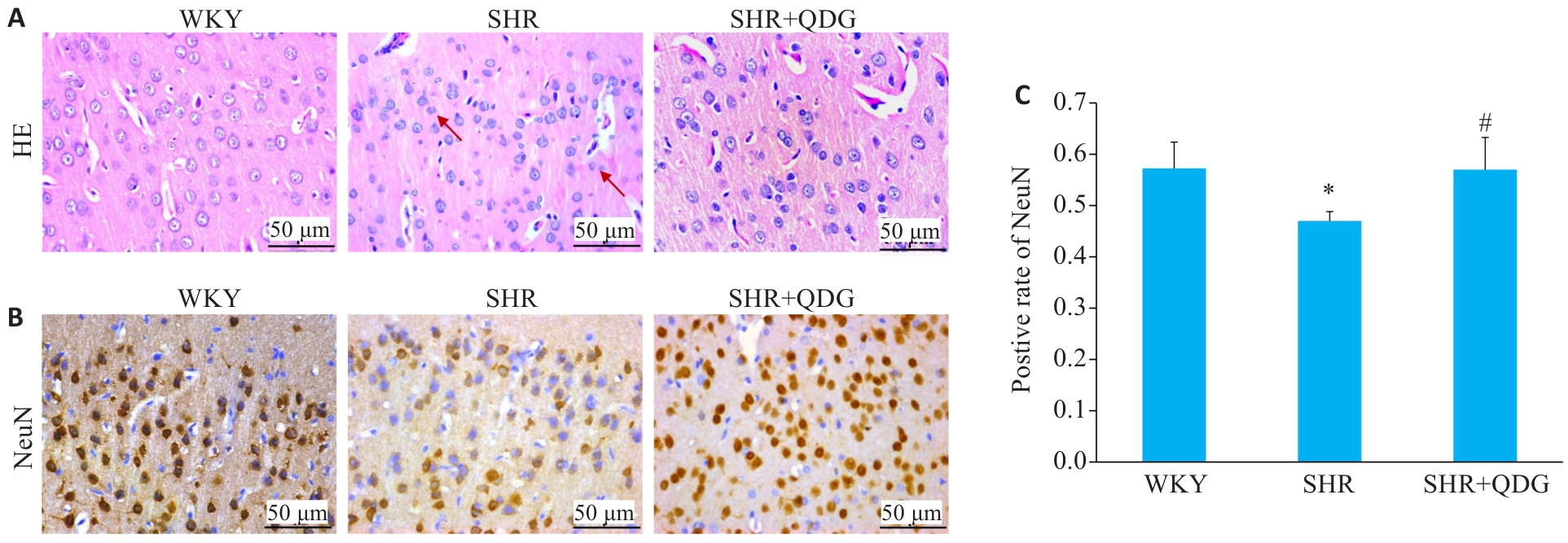
Fig.2 Effects of Qingda Granules on pathological changes and neuron number in the cerebral cortex of SHRs. A: HE staining of the cortical area of the brain. B, C: Immunohistochemistry for detecting the protein expression of NeuN. Arrows indicate neuronal shrinkage. *P<0.05 vs WKY group; #P<0.05 vs SHR group.
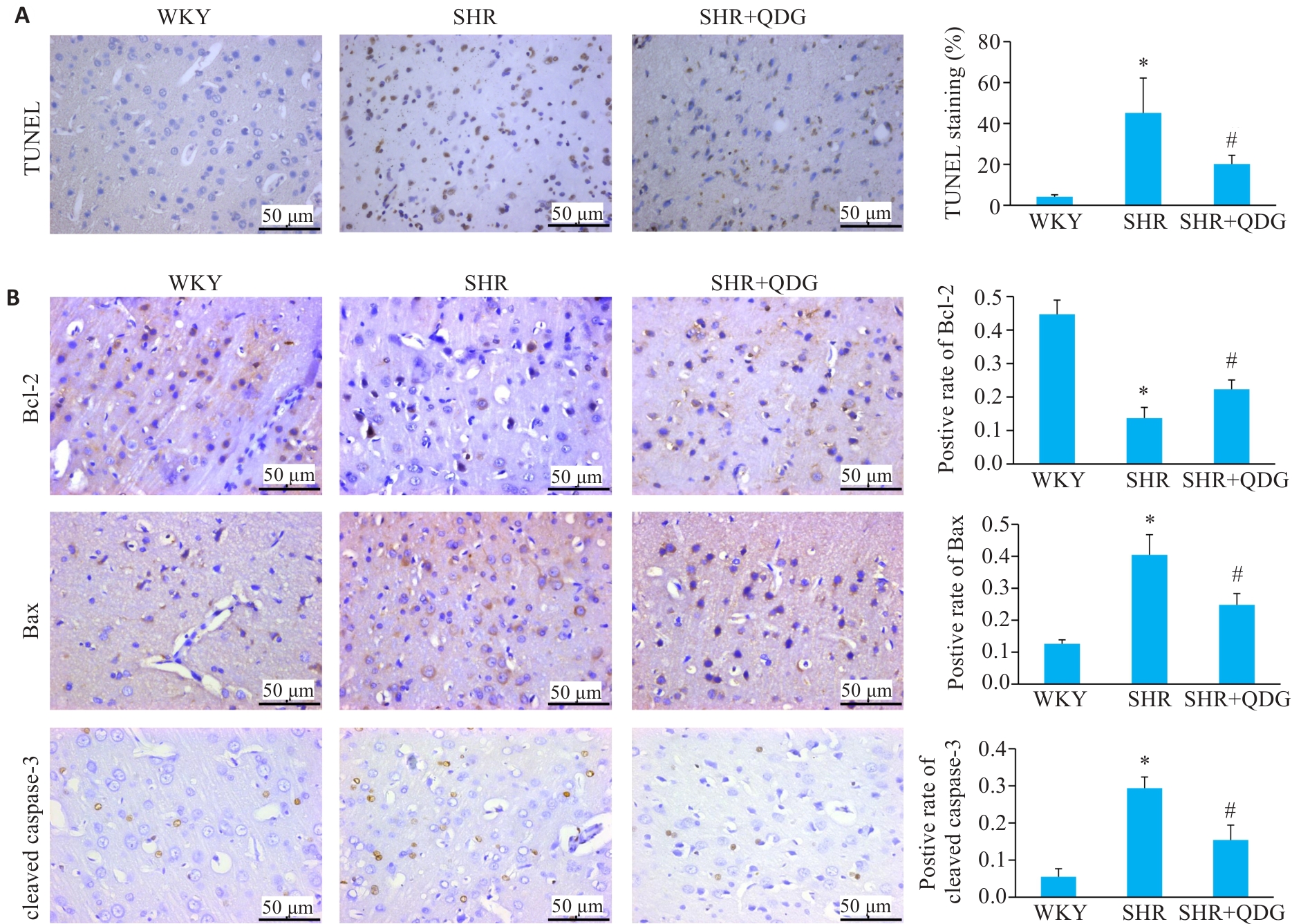
Fig.3 Effects of Qingda Granules on neuronal apoptosis and protein expressions of Bcl-2, Bax and cleaved caspase-3 in the cerebral cortex of SHRs. A: TUNEL staining for detecting neuronal apoptosis. B: Immunohistochemistry for detecting protein expression of Bcl-2, Bax and cleaved caspase-3. *P<0.05 vs WKY group; #P<0.05 vs SHR group.
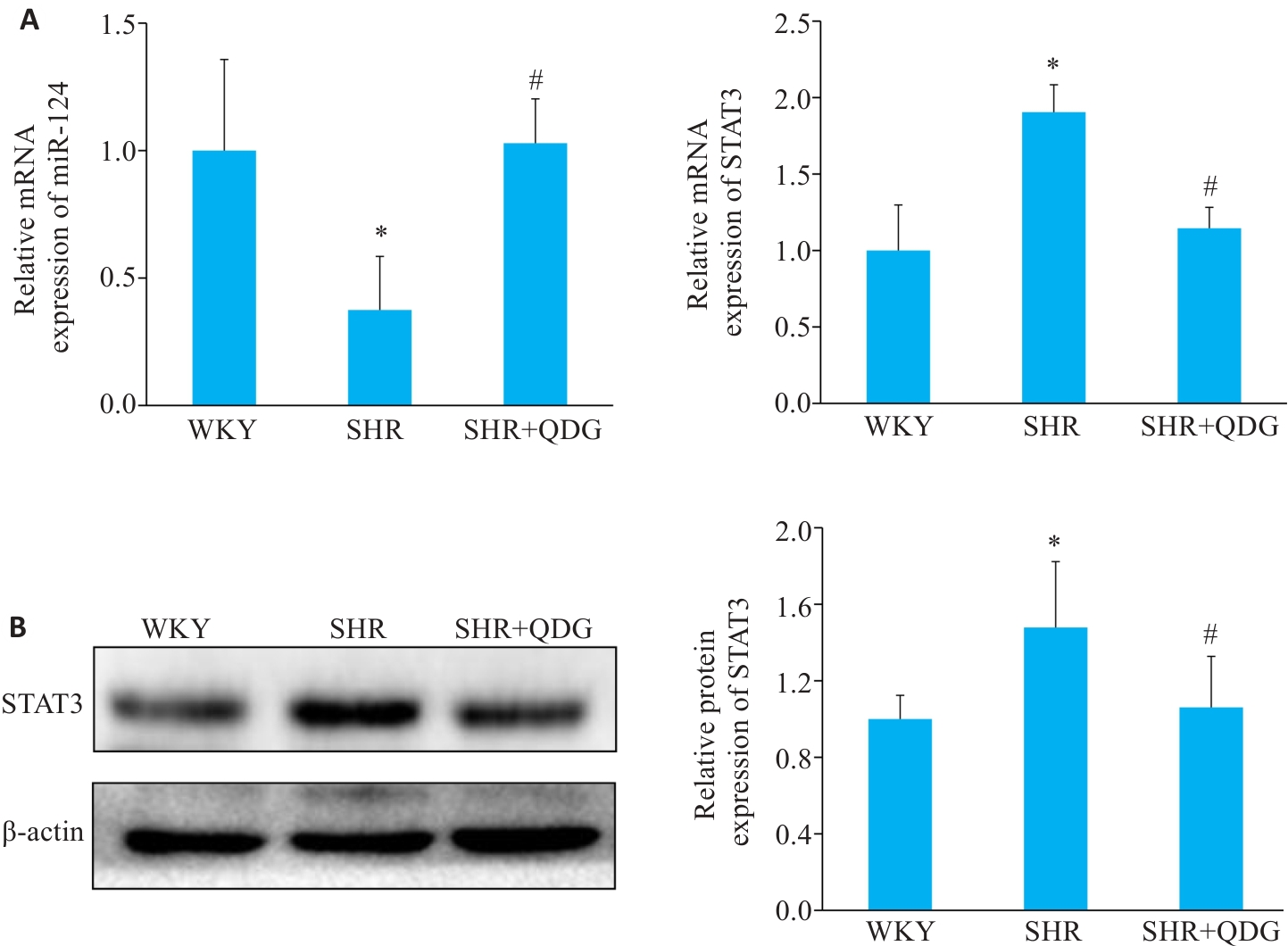
Fig. 4 Effect of Qingda Granules on expressions of miR-124 and STAT3 in the cerebral cortex of SHR rats. A: RT-qPCR analysis of mRNA expression of miR-124 and STAT3. B: Western blotting for detecting protein expressions of STAT3. *P<0.05 vs WKY group; #P<0.05 vs SHR group.
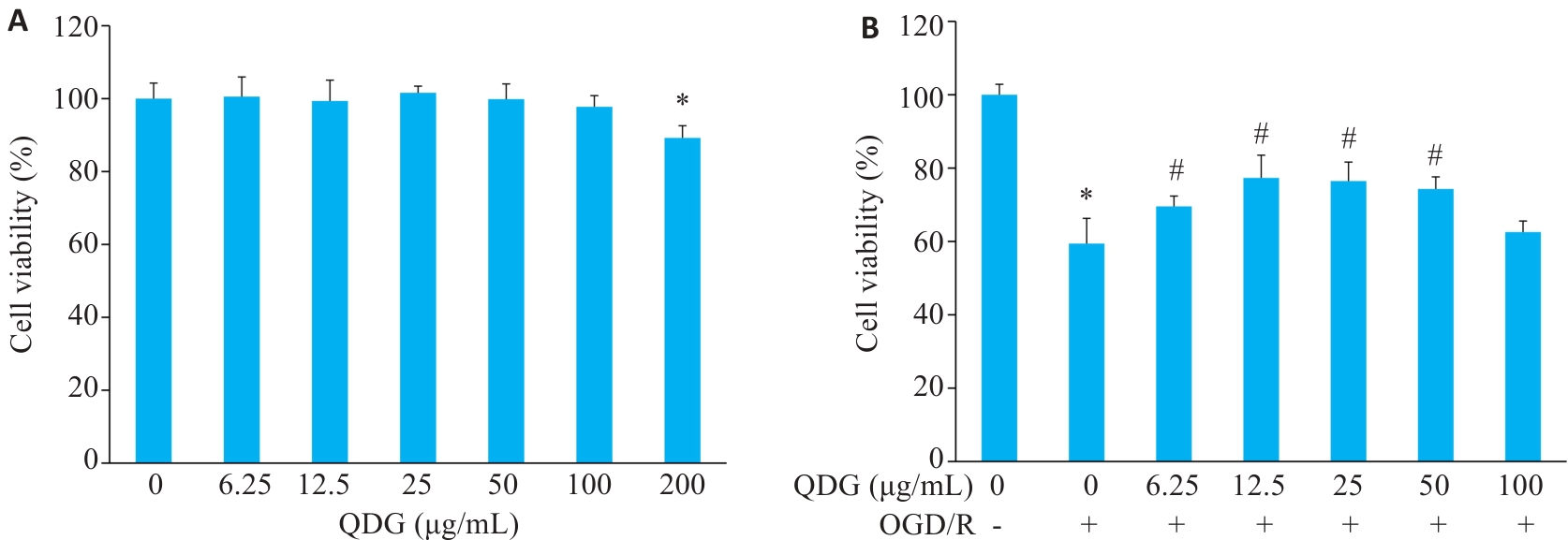
Fig.5 Effect of Qingda Granules on viability of HT22 cells with OGD/R. A: CCK-8 assay of viability of HT22 cells treated with different concentrations of Qingda Granules. B: CCK-8 assay of viability HT22 cells with OGD/R and Qingda Granules treatment. *P<0.05 vs 0 μg/mL group; #P<0.05 vs OGD/R group.
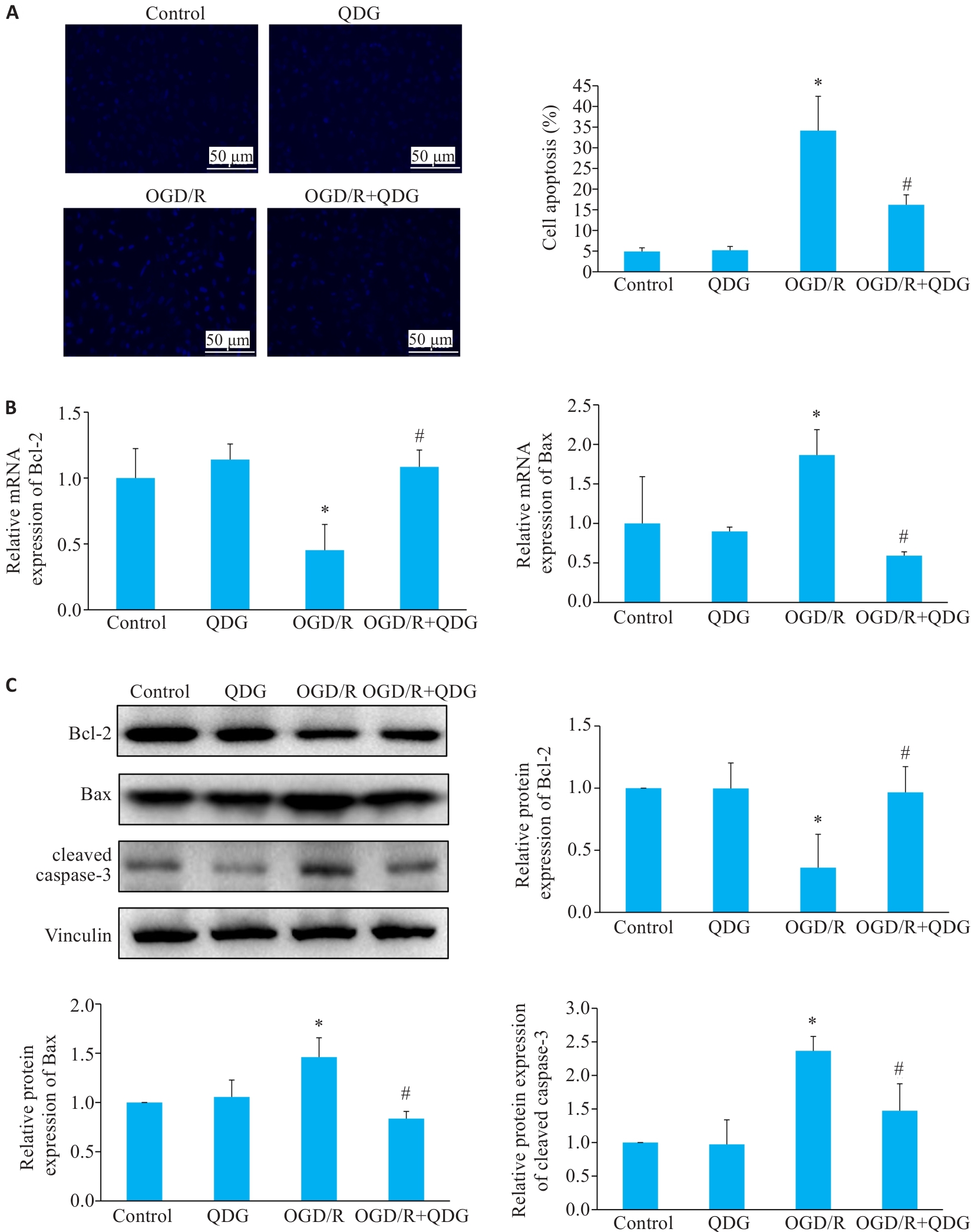
Fig.6 Effect of Qingda Granules on apoptosis and expressions of Bcl-2, Bax and cleaved caspase-3 in OGD/R-induced HT22 cells. A: Hoechst 33342 staining for detecting cell apoptosis. B: RT-qPCR analysis of mRNA expressions of Bcl-2 and Bax. C: Western blotting for detecting protein expressions of Bcl-2, Bax and cleaved caspase-3. *P<0.05 vs Control group; #P<0.05 vs OGD/R group.
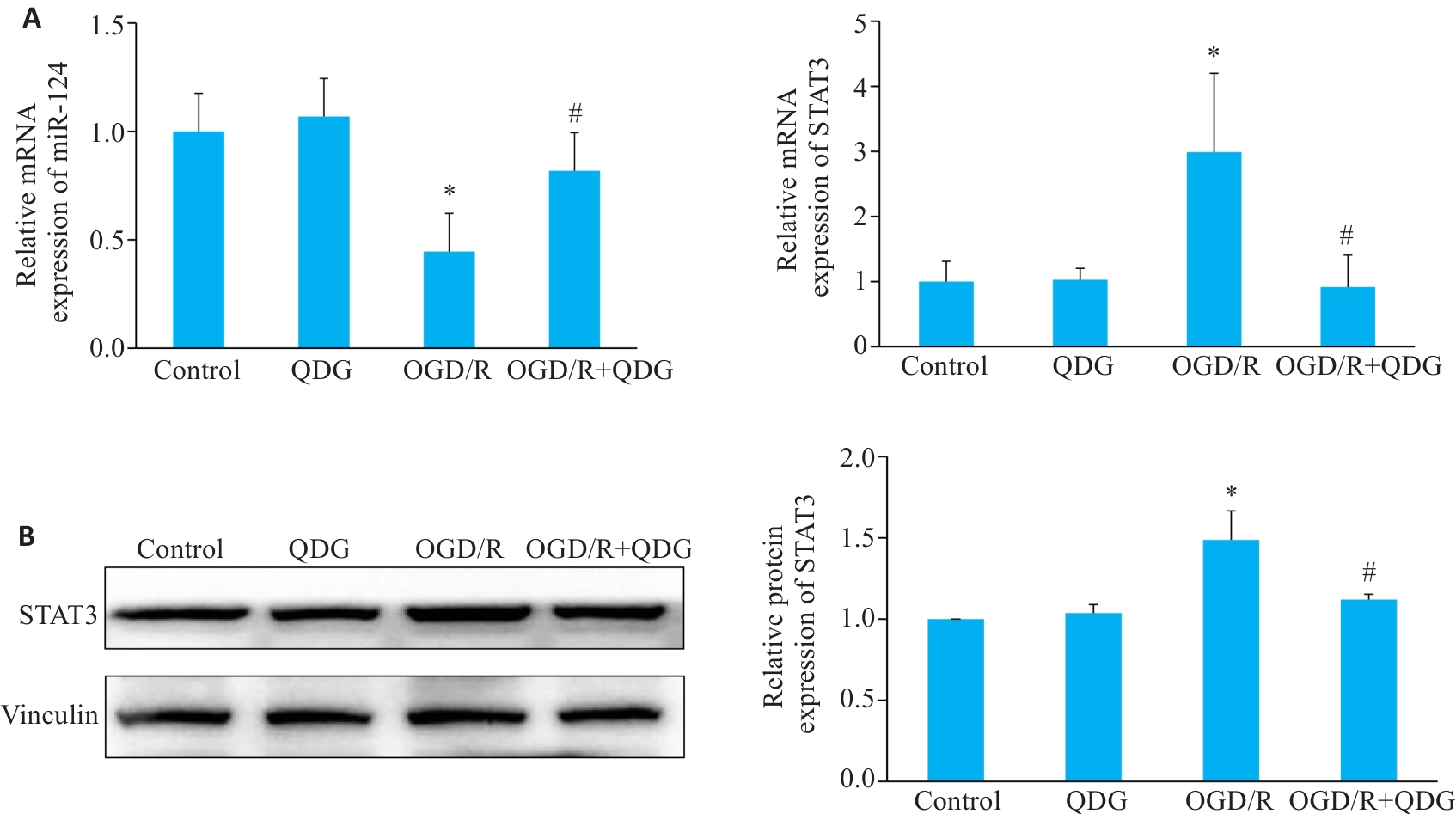
Fig.7 Effect of Qingda Granules on expression of miR-124 and STAT3 in OGD/R-induced HT22 cells. A: RT-qPCR analysis of mRNA expression of miR-124 and STAT3. B: Western blotting for detecting STAT3 protein expression. *P<0.05 vs Control group; #P<0.05 vs OGD/R group.
| 1 | Mills KT, Bundy JD, Kelly TN, et al. Global disparities of hypertension prevalence and control: a systematic analysis of population-based studies from 90 countries[J]. Circulation, 2016, 134(6): 441-50. |
| 2 | Wang ZW, Chen Z, Zhang LF, et al. Status of hypertension in China: results from the China hypertension survey, 2012-2015[J]. Circulation, 2018, 137(22): 2344-56. |
| 3 | India State-Level Disease Burden Initiative Collaborators. Nations within a nation: variations in epidemiological transition across the states of India, 1990-2016 in the Global Burden of Disease Study[J]. Lancet, 2017, 390(10111): 2437-60. |
| 4 | Ruan Z, Lu Q, Wang JE, et al. MIF promotes neurodegeneration and cell death via its nuclease activity following traumatic brain injury[J]. Cell Mol Life Sci, 2021, 79(1): 39. |
| 5 | Srinivasan S, Treacy R, Herrero T, et al. Discovery and verification of extracellular miRNA biomarkers for non-invasive prediction of pre-eclampsia in asymptomatic women[J]. Cell Rep Med, 2020, 1(2): 100013. |
| 6 | Sotomayor-Flores C, Rivera-Mejías P, Vásquez-Trincado C, et al. Angiotensin‑(1-9) prevents cardiomyocyte hypertrophy by controlling mitochondrial dynamics via miR-129-3p/PKIA pathway[J]. Cell Death Differ, 2020, 27(9): 2586-604. |
| 7 | Mishima T, Mizuguchi Y, Kawahigashi Y, et al. RT-PCR-based analysis of microRNA (miR-1 and-124) expression in mouse CNS[J]. Brain Res, 2007, 1131(1): 37-43. |
| 8 | Geng JQ, Feng JP, Ke FZ, et al. MicroRNA-124 negatively regulates STAT3 to alleviate hypoxic-ischemic brain damage by inhibiting oxidative stress[J]. Aging, 2024, 16(3): 2828-47. |
| 9 | Angelopoulou E, Paudel YN, Piperi C. MiR-124 and Parkinson's disease: a biomarker with therapeutic potential[J]. Pharmacol Res, 2019, 150: 104515. |
| 10 | Sun H, Li JJ, Feng ZR, et al. MicroRNA-124 regulates cell pyroptosis during cerebral ischemia-reperfusion injury by regulating STAT3[J]. Exp Ther Med, 2020, 20(6): 227. |
| 11 | 陈晓萍, 程 瑛, 刘慧馨, 等. 基于代谢组学研究清达颗粒减轻高血压所致心脏损伤的生物学机制[J]. 中国中医基础医学杂志, 2023, 29(1): 79-85, 182. |
| 12 | Qu H, Shen AL, Yang K, et al. Efficacy and safety of Qingda Granule versus valsartan capsule in Chinese grade 1 hypertensive patients with low-moderate risk: a randomized, double-blind, double dummy, non-inferiority, multi-center trial[J]. Pharmacol Res, 2024, 200: 107052. |
| 13 | Wu XY, Shen AL, Bao LY, et al. Qingda granules attenuate hypertensive cardiac remodeling and inflammation in spontaneously hypertensive rats[J]. Biomed Pharmacother, 2020, 129: 110367. |
| 14 | Wu MZ, Zhang SY, Zhang WQ, et al. Qingda granule ameliorates vascular remodeling and phenotypic transformation of adventitial fibroblasts via suppressing the TGF‑β1/Smad2/3 pathway[J]. J Ethnopharmacol, 2023, 313: 116535. |
| 15 | Chen XP, Long LZ, Cheng Y, et al. Qingda granule attenuates cardiac fibrosis via suppression of the TGF‑β1/Smad2/3 signaling pathway in vitro and in vivo [J]. Biomed Pharmacother, 2021, 137: 111318. |
| 16 | Chen DX, Long LZ, Lin S, et al. Qingda granule alleviate angiotensin ⅱ-induced hypertensive renal injury by suppressing oxidative stress and inflammation through NOX1 and NF‑κB pathways[J]. Biomed Pharmacother, 2022, 153: 113407. |
| 17 | Zhang L, Cai QY, Lin S, et al. Qingda granule exerts neuroprotective effects against ischemia/reperfusion-induced cerebral injury via lncRNA GAS5/miR-137 signaling pathway[J]. Int J Med Sci, 2021, 18(7): 1687-98. |
| 18 | 叶任之, 张 铃, 蔡巧燕, 等. 基于p38MAPK/Nrf2/HO-1通路探讨清达颗粒对脂多糖诱导活化的小胶质细胞抗氧化作用研究[J]. 中西医结合心脑血管病杂志, 2020, 18(11): 1700-6. |
| 19 | Cai QY, Zhao CY, Xu YY, et al. Qingda granule alleviates cerebral ischemia/reperfusion injury by inhibiting TLR4/NF‑κB/NLRP3 signaling in microglia[J]. J Ethnopharmacol, 2024, 324: 117712. |
| 20 | Kelly DM, Rothwell PM. Blood pressure and the brain: the neurology of hypertension[J]. Pract Neurol, 2020, 20(2): 100-8. |
| 21 | Lewington S, Clarke R, Qizilbash N, et al. Age-specific relevance of usual blood pressure to vascular mortality: a meta-analysis of individual data for one million adults in 61 prospective studies[J]. Lancet, 2002, 360(9349): 1903-13. |
| 22 | Li J. Traditional Chinese medicine in treating hypertension[J]. Circ Cardiovasc Qual Outcomes, 2022, 15(3): e008723. |
| 23 | Wang MX, Wu CJ, Cao PH, et al. Meta-analysis for clinical efficacy of traditional Chinese medicine in treating resistant hypertension[J]. Chin J Chin Mater Med, 2021, 46(3): 685-93. |
| 24 | Cheng Y, Shen AL, Wu XY, et al. Qingda granule attenuates angiotensin II-induced cardiac hypertrophy and apoptosis and modulates the PI3K/AKT pathway[J]. Biomedecine Pharmacother, 2021, 133: 111022. |
| 25 | Tajima A, Hans FJ, Livingstone D, et al. Smaller local brain volumes and cerebral atrophy in spontaneously hypertensive rats[J]. Hypertension, 1993, 21(1): 105-11. |
| 26 | Pires PW, Dams Ramos CM, Matin N, et al. The effects of hypertension on the cerebral circulation[J]. Am J Physiol Heart Circ Physiol, 2013, 304(12): H1598-614. |
| 27 | Hsieh MH, Cui ZY, Yang AL, et al. Cerebral cortex apoptosis in early aged hypertension: effects of epigallocatechin-3-gallate[J]. Front Aging Neurosci, 2021, 13: 705304. |
| 28 | Yang LJ, Cui H, Cao T. Negative regulation of miRNA-9 on oligodendrocyte lineage gene 1 during hypoxic-ischemic brain damage[J]. Neural Regen Res, 2014, 9(5): 513-8. |
| 29 | Vinciguerra A, Formisano L, Cerullo P, et al. MicroRNA-103-1 selectively downregulates brain NCX1 and its inhibition by anti-miRNA ameliorates stroke damage and neurological deficits[J]. Mol Ther, 2014, 22(10): 1829-38. |
| 30 | 耿佳庆, 方成志, 张丙宏. MicroRNA-124在神经系统中的研究进展[J]. 武汉大学学报(医学版), 2024, 45(11): 1403-9. |
| 31 | 职 瑾, 段 斌, 王 静, 等. MiR-124与MAPK/ERK通路对调节脑梗死大鼠神经细胞凋亡的影响[J]. 现代生物医学进展, 2021, 21(12): 2235-40. |
| 32 | Matsuoka H, Tamura A, Kinehara M, et al. Levels of tight junction protein CLDND1 are regulated by microRNA-124 in the cerebellum of stroke-prone spontaneously hypertensive rats[J]. Biochem Biophys Res Commun, 2018, 498(4): 817-23. |
| 33 | Shu K, Zhang YL. Protodioscin protects PC12 cells against oxygen and glucose deprivation-induced injury through miR-124/AKT/Nrf2 pathway[J]. Cell Stress Chaperones, 2019, 24(6): 1091-9. |
| 34 | Fathi N, Rashidi G, Khodadadi A, et al. STAT3 and apoptosis challenges in cancer[J]. Int J Biol Macromol, 2018, 117: 993-1001. |
| 35 | You LK, Wang ZG, Li HS, et al. The role of STAT3 in autophagy[J]. Autophagy, 2015, 11(5): 729-39. |
| 36 | Xia TT, Zhang M, Lei W, et al. Advances in the role of STAT3 in macrophage polarization[J]. Front Immunol, 2023, 14: 1160719. |
| 37 | Hristova M, Rocha-Ferreira E, Fontana X, et al. Inhibition of Signal Transducer and Activator of Transcription 3 (STAT3) reduces neonatal hypoxic-ischaemic brain damage[J]. J Neurochem, 2016, 136(5): 981-94. |
| 38 | Tang SJ, Lai NS, Xu L. Neuronal pyroptosis mediated by STAT3 in early brain injury after subarachnoid hemorrhage[J]. Brain Res, 2024, 1822: 148666. |
| 39 | Wei J, Wang F, Kong LY, et al. MiR-124 inhibits STAT3 signaling to enhance T cell-mediated immune clearance of glioma[J]. Cancer Res, 2013, 73(13): 3913-26. |
| 40 | 龚翠兰, 马 强, 杨仁义, 等. 基于JAK2/STAT3通路探讨活血荣络方对OGD/R后BMEC的干预作用及机制[J]. 湖南中医药大学学报, 2024, 44(3): 350-6. |
| 41 | 弋海群, 谢 娟, 张象霞, 等. 蛇葡萄素通过调节JAK2/STAT3信号通路减轻OGD/R诱导的神经元损伤[J]. 国际检验医学杂志, 2024, 45(1): 89-94. |
| [1] | Qiongqiong HU, Wenpei LI, Lixia XU, Ruilei GUAN, Dongya ZHANG, Jiaojiao JIANG, Ning WANG, Gaiqing YANG. Neurospecific transmembrane protein 240 colocalizes with peroxisomes and activates Rho GDP dissociation inhibitor β [J]. Journal of Southern Medical University, 2025, 45(6): 1260-1269. |
| [2] | Guanglü HE, Wanyu CHU, Yan LI, Xin SHENG, Hao LUO, Aiping XU, Mingjie BIAN, Huanhuan ZHANG, Mengya WANG, Chao ZHENG. Orexin-A promotes motor function recovery of rats with spinal cord injury by regulating ionotropic glutamate receptors [J]. Journal of Southern Medical University, 2025, 45(5): 1023-1030. |
| [3] | Luyu LIU, Maowei GONG, Guosong LIAO, Weixing ZHAO, Qiang FU. Hypertension exacerbates postoperative learning and memory impairment in rats possibly due to UCP2 downregulation-mediated mitochondrial dysfunction [J]. Journal of Southern Medical University, 2025, 45(4): 725-735. |
| [4] | Yue CHEN, Linyu XIAO, Lü REN, Xue SONG, Jing LI, Jianguo HU. Monotropein improves motor function of mice with spinal cord injury by inhibiting the PI3K/AKT signaling pathway to suppress neuronal apoptosis [J]. Journal of Southern Medical University, 2025, 45(4): 774-784. |
| [5] | Hanjun ZUO, Zhaoda DUAN, Zhao WANG, Tao GUO, Jinsha SHI, Haolong SHI, Juanjuan LI. Gastrodin improves microglia-mediated inflammatory response after hypoxic-ischemic brain damage in neonatal rats via PI3K/AKT pathway [J]. Journal of Southern Medical University, 2024, 44(9): 1712-1719. |
| [6] | LI Yanxiang, GUO Yongxin, CAO Fuyang, GUO Shuting, XUE Dinghao, ZHOU Zhikang, HAO Xinyu, TONG Li, FU Qiang. Inhibition of glutamatergic neurons in the dorsomedial periaqueductal gray alleviates excessive defensive behaviors of mice with post-traumatic stress disorder [J]. Journal of Southern Medical University, 2024, 44(3): 420-427. |
| [7] | GUI Jianjun, SUN Xiaodong, WEN Shu, LIU Xin, QIN Bingqing, SANG Ming. Resveratrol protects dopaminergic neurons in a mouse model of Parkinson's disease by regulating the gut-brain axis via inhibiting the TLR4 signaling pathway [J]. Journal of Southern Medical University, 2024, 44(2): 270-279. |
| [8] | Jiawei HU, Fang DU, Lu DING, Luxiang WANG, Weifeng ZHAO. Risk assessment of hepatocellular carcinoma in patients with hepatitis B-related cirrhosis and hypertension: a propensity score matching-based retrospective cohort study [J]. Journal of Southern Medical University, 2024, 44(11): 2243-2249. |
| [9] | Jinsha SHI, Haonan ZHANG, Xinglin ZHANG, Haolong SHI, Hanjun ZUO, Tao GUO, Zhao WANG, Hang YU, Juanjuan LI. Gastrodin alleviates microglia-mediated inflammatory responses in neonatal mice with hypoxic-ischemic brain damage by regulating CCR5/AKT signaling [J]. Journal of Southern Medical University, 2024, 44(10): 1850-1857. |
| [10] | Lei WANG, Fenlan BIAN, Feiyang MA, Shu FANG, Zihan LING, Mengran LIU, Hongyan SUN, Chengwen FU, Shiyao NI, Xiaoyang ZHAO, Xinru FENG, Zhengyu SUN, Guoqing LU, Pinfang KANG, Shili WU. Activation of ALDH2 alleviates hypoxic pulmonary hypertension in mice by upregulating the SIRT1/PGC-1α signaling pathway [J]. Journal of Southern Medical University, 2024, 44(10): 1955-1964. |
| [11] | ZHANG Ningning, QIU Qi, CHEN Yongfeng, SUN Zhengyu, LU Guoqing, WANG Lei, KANG Pingfang, WANG Hongju. Quercetin improves pulmonary arterial hypertension in rats by regulating the HMGB1/RAGE/NF-κB pathway [J]. Journal of Southern Medical University, 2023, 43(9): 1606-1612. |
| [12] | WEI Xixi, LI Chaohong, ZHAO Chenlu, ZHAO Baosheng, LIU Yuzhen. Characterization of metabotropic glutamate receptor 7 and 8 in rat superior cervical ganglion and their changes following chronic intermittent hypoxia [J]. Journal of Southern Medical University, 2023, 43(7): 1172-1178. |
| [13] | CAO Fuyang, GUO Yongxin, GUO Shuting, ZHOU Zhikang, CAO Jiangbei, TONG Li, MI Weidong. Activation of GABAergic neurons in the zona incerta accelerates anesthesia induction with sevoflurane and propofol without affecting anesthesia maintenance or awakening in mice [J]. Journal of Southern Medical University, 2023, 43(5): 718-726. |
| [14] | DU Changle, WANG Yu, FU Jifeng, CAO Dongli, MEI Renbiao, ZHANG Qi. Inducible co-stimulatory molecules participate in mesenteric vascular endothelial-mesenchymal transition and sclerosis of mesenteric vessels in spontaneously hypertensive rats [J]. Journal of Southern Medical University, 2023, 43(2): 308-316. |
| [15] | LIANG Libing, CHEN Jingjuan, ZHANG Chengguo, WANG Yukai, LUO Baigui, ZHOU Tianen, WANG Xiaofeng. Serum lipoprotein-associated phospholipase A2 level is positively correlated with the recurrence risk of acute ischemic cerebral infarction in hypertensive patients [J]. Journal of Southern Medical University, 2023, 43(2): 317-322. |
| Viewed | ||||||
|
Full text |
|
|||||
|
Abstract |
|
|||||